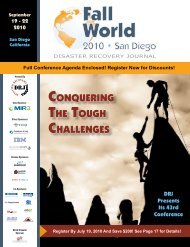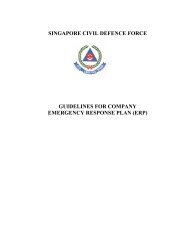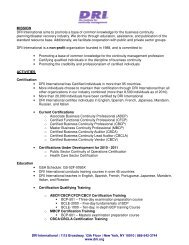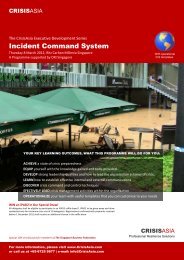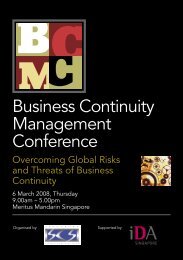Framework for Voluntary Preparedness - Association of Contingency ...
Framework for Voluntary Preparedness - Association of Contingency ...
Framework for Voluntary Preparedness - Association of Contingency ...
You also want an ePaper? Increase the reach of your titles
YUMPU automatically turns print PDFs into web optimized ePapers that Google loves.
<strong>Framework</strong> For <strong>Voluntary</strong> <strong>Preparedness</strong><br />
<strong>Preparedness</strong> involves issues and actions be<strong>for</strong>e, during and after a disruptive incident. There<strong>for</strong>e,<br />
preparedness encompasses prevention, deterrence, readiness, mitigation, response, continuity, and<br />
recovery. Various disciplines, practitioners and organizations focus different weight on these<br />
components <strong>of</strong> preparedness. However, throughout this paper, the term “preparedness” is used in an<br />
inclusive sense <strong>of</strong> all phases be<strong>for</strong>e, during and after a disruptive event. The Interdisciplinary Team<br />
approached the work commissioned by the Sloan Foundation by first considering what core elements<br />
must be in place to increase the probability <strong>of</strong> a private sector company‟s continued sustainability and<br />
resiliency in light <strong>of</strong> a disruptive event, regardless <strong>of</strong> cause.<br />
Core Elements in Relation to Regulations<br />
Regulations are mandatory authoritative rules dealing with details or procedures having the <strong>for</strong>ce <strong>of</strong><br />
law, which are issued by an authority <strong>of</strong> government. The Interdisciplinary Team reviewed the<br />
following relevant U.S. regulations to discover core elements already required <strong>of</strong> certain regulated<br />
industries: SEC, NASD, NERC, HIPAA, FFIEC. The Interdisciplinary Team recognizes that organizations<br />
are subject to multiple regulations. It is not our intent to complete a study <strong>of</strong> all potential regulations<br />
that enterprises might face. The purpose <strong>of</strong> the review <strong>for</strong> this work is to determine whether certain<br />
regulations contain the identified core elements. Furthermore, regulatory audits <strong>of</strong> the regulatory<br />
requirements provide evidence <strong>of</strong> preparedness con<strong>for</strong>mity with standards and best practices. The<br />
Interdisciplinary Team confirmed commonalities with respect to certain core elements contained within<br />
these identified various regulations.<br />
Core Elements in Relation to Standards<br />
Standards are a set <strong>of</strong> voluntary criteria, voluntary guidelines and best practices used to enhance the<br />
quality, per<strong>for</strong>mance, reliability and consistency <strong>of</strong> products, services and/or processes. International,<br />
national and regional standards bodies have initiated aggressive standards development programs<br />
addressing preparedness management. Generic management standards assure that an<br />
organization‟s management approach has a number <strong>of</strong> essential features in support <strong>of</strong> how it<br />
manages its processes, or activities. Standards are applicable to any organization, large or small,<br />
whatever its function, products, or services. These standards typically include provisions <strong>for</strong> either first,<br />
second, or third party auditing and validation <strong>of</strong> meeting the requirements <strong>of</strong> the standard.2<br />
Standards are an alternative to regulations. In contrast to regulations, standards are market-driven<br />
by the sectors that will put them to use. Standards may become recognized as industry best practice<br />
and a market requirement. However, this is an acceptance and developing process over time within<br />
the private sector, not a legislated process. The Interdisciplinary Team reviewed the following<br />
standards and proposed standards as being pertinent to U.S. business preparedness: NFPA 1600-<br />
2007 Standard on Disaster/Emergency Management and Business Continuity Programs, ISO/PAS<br />
22399-2007, ASIS International Organizational Resilience: <strong>Preparedness</strong> and Continuity Management<br />
– Best Practices Standard, BS 25999-2:2007 Business Continuity Management – Part 2 –<br />
Specification, and CSA Z1600 Standard on Emergency Management and Business Continuity<br />
Programs. The Interdisciplinary Team confirmed the commonality <strong>of</strong> the core elements contained<br />
within these standards and proposed standards.<br />
2 First party self-reporting and self-declaration (e.g., checklist against core elements or internal audit review); Second party<br />
review against core elements (e.g., supply chain audit verification by clients); Third party auditing and validation against core<br />
elements or existing standards (e.g., outside auditors checklist and test against core elements or full standard certification)<br />
Page 3



